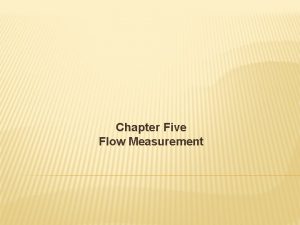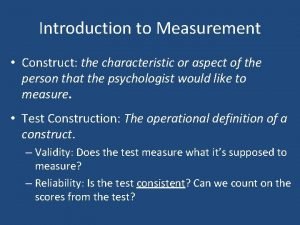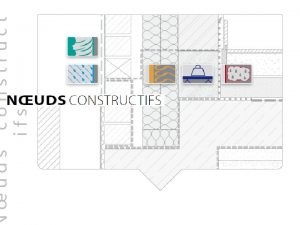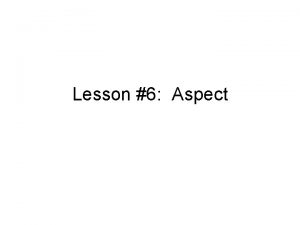Introduction to Measurement Construct the characteristic or aspect










- Slides: 10

Introduction to Measurement • Construct: the characteristic or aspect of the person that the psychologist would like to measure. • Test Construction: The operational definition of a construct. – Validity: Does the test measure what it’s supposed to measure? – Reliability: Is the test consistent? Can we count on the scores from the test?

True-Score Theory • True Score: Place on the scale of possible scores where the person really is. X = True score X = True Score + Error

Where does the “error” come from? 1. Test Construction • Domain of Sampling: the full set of information to assess a construct. • The measure may: – Obtain information from a different construct – Not obtain all the information relevant to a construct.

Errors in Test Construction – Cont’d 2. Test Administration 1. Differences in testing materials 2. Differences in testing conditions 3. Differences about the examiner 3. Test Scoring and Interpretation

Reliability refers to the consistency of the testing instrument. 1. Test-retest reliability 2. Internal consistency: All the items are measuring the same construct. – Split-half reliability – Cronbach’s Alpha (Coefficient Alpha): average correlation among the items. • . 8 is a good number to aim for.

Correlation Matrix Average correlation =. 75 1. Dedicate my life to Stats … 2. I hate stats 3. I enjoy my statistics courses 4. I would rather break my leg… 1 2 3 4 1. 0 -. 75 +. 84 -. 65 1. 0 -. 92 +. 73 1. 0 -. 62 1. 0

Validity • Validity: the test measures what it is supposed to measure. • Construct Validity: The test measures the construct it is supposed to measure – Convergent Validity: the test is strongly correlated with other measures of the same construct – Discriminant Validity: The test is not strongly correlated with tests measuring different constructs

Correlation Matrix Assessing Construct Validity 1. Pierce Depression Scale 2. Beck Depression Inventory 3. I Like Dirt Scale 1 2 3 1. 0 +. 65 -. 04 1. 0 +. 07 1. 0

Correlation Matrix Convergent Validity 1. Pierce Depression Scale 2. Beck Depression Inventory 3. I Like Dirt Scale Discriminant Validity 1 2 3 1. 0 +. 65 -. 04 1. 0 +. 07 1. 0




















